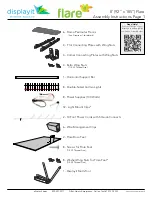
Lucent Technologies Lineage
®
2000 25A Ferroresonant Rectifier J85502A-1
Issue 4 May 1998
Installation 5 - 5
DC Output Power
The majority of dc power plants for telecommunication
applications are designed to use single conductor cables (in
parallel for current capacity or to limit voltage drop) supported
on ladder racks. Experience has shown that the use of flexible
cables (welding type cables) makes installation of this type
wiring much simpler. The terminals are sized to fit KS24194 L2
wire, which is very flexible.
Figure 5-1 shows the dc output conduit hole. Figure 5-2 shows
the dc output wire termination points for both negative and
positive polarity. Table 5-B specifies the dc output cable and
conduit sizes.
Installation Tools
The following tools are required for installing rectifiers.
•
Material handling equipment to unload rectifiers at site,
uncrate them, and place them in final positions
•
Common electrician's hand tools, including jeweler's
screwdriver, electrical tape, wire cutters and strippers,
14 AWG to 8 AWG wire
•
Proper crimping tools and dies for connectors used
•
Common mechanic's hand tools, including flat blade
screwdriver (.30 inch blade width), socket and torque
wrench for 3/8 inch bolts, channel lock pliers for ac conduit
tightening, hammer, and crowbar for uncrating
•
Digital multimeter (DMM) Fluke
®
8060A or equivalent
with ±0.02 percent accuracy on dc scale
Unpacking
Move the crated rectifier to a convenient area for uncrating and
follow the steps listed below.
1. Remove any shipping bands.
2. Check “tilt” or “shock” indicators. If tripped, contact
shipping company and process claims form.
3. Pry off top, then sides of crate.
4. Inspect exposed exterior of rectifier for shipping damage.
















































